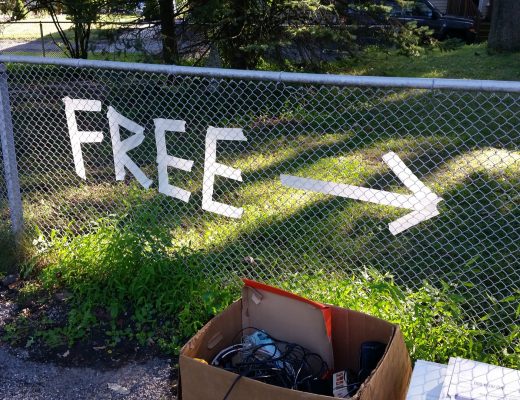For some odd reason, Canadians love to debate RRSPs vs. TFSAs.
Not only do people debate, but they even get heated and judgmental. With so many opinions and judgments, people become discouraged from engaging in these important financial conversations.
This bothers me:I feel like people are missing the forest for the trees.
Instead of focusing on what REALLY matters—the art of saving—they are distracted by all the details and by trying to impress their friends with their knowledge.
The key is to develop ridiculously good money and saving habits. Once this is underway, then sure… let’s talk RRSPs vs. TFSAs… or any other investment tool for that matter.
The point is, it’s much more important to learn how to save first and to make sure you are following through on that plan day-by-day, week-by-week, and month-by-month.
Do you remember the tele-commercial “Ronco Showtime Rotisserie?”
Despite that he was talking about how to cook the best chicken, his message is PERFECT for when it comes to saving: “Just set it and forget it!”

What’s the point of RRSPs and TFSAs?
Both are tax efficient investment tools that were designed to help Canadians invest and build wealth for their retirement. As discussed in the post The Magic of Compound Interest , investment growth can be tax deferred (RRSP), meaning you don’t pay taxes on the immediate growth = thumbs up! And your TFSA is just tax free!
In this post, you won’t find a straight answer as to what you specifically need to use: RRSP or TFSA.
Why?
Because personal finance is just that… it’s personal and depends on so many other factors. I hope to help simplify the main differences between an RRSP and TFSA so that you can make an informed decision.
What are the main differences between a TFSA and RRSP?
- How the money goes in and out of the accounts
- RRSP contributions:
- Your RRSP contributions are a tax deduction on your taxable income.
- For example, if you earned $50,000 a year and contributed $5,000 into your RRSP, your taxable income will be reduced to $45,000… this reduces your taxes. (Note: after your tax deduction, the money you put into your RRSP will be pre-taxed.)
- For an RRSP, you need earned income to contribute.
- RRSP/RRIF withdraws:
- Once you decide to turn your RRSP into an income stream, you need to convert the plan into an registered Retirement Savings Plan (RRIF).
- All the money that comes out of this account is fully taxable to you.
- Both your initial contributions and your growth are taxed because you have NOT paid in taxes on this money yet.
- You must start withdrawing your money from your RRSP (which turns in to a RRIF) at age 71.
- TFSA contributions:
- Unlike an RRSP, you do not need earned income to contribute, however you need to be 18 years old and a Canadian.
- These contributions are NOT tax deductible.
- Your contribution is made with after-tax dollars, which means you have NO TAX to pay when you withdraw those funds later in life.
- Nice! But it gets better…
- TFSA withdraws:
- As mentioned above, your contributions are not taxable when you withdraw them. In addition, any investment growth accumulated inside your TFSA will be paid out tax free!
- This is the amazing part of a TFSA.
- Unlike the RRSP, you aren’t forced to start withdrawing funds from your TFSA at specific date.
- RRSP contributions:
What are the maximum contributions?
RRSP:
You can contribute up to 18% of your annual earned income up to a maximum of $26,230 contributions per year in 2019. This would be a salary of approx. $145,700. (Note: this annual amount changes each year.)
TFSA:
TFSAs were introduced in 2009. Their contributions are not linked to your earned income, so even if you don’t have a job or earned income (say you receive dividend income) you can still contribute if you are 18 years old or older. Annual maximum contributions have varied since 2009 from $5,000 to $6,000 in 2009. As of 2009, the total contribution limit is now $63.500.
What happens if you did not make full contribution?
Well, there is no need to worry! With both the RRSP and TFSA you can make up any missed contributions!
TFSA: the double-edged sword
As mentioned, both of your contributions and investment growth held in a TFSA can be withdrawn tax free…this is amazing. However, this is also a double-edged sword as it exposes you to danger.
And that danger is… you!
If you have ever seen the movie Fight Club, you might remember the scene when Edward Norton is throwing haymaker punches at his own bruised face.
With personal finances, we are often the enemy in the mirror. Too often Canadians aren’t using their TFSAs for investing for long term purposes (which prevents us from maximizing their potential). Instead, the lure of taking tax free money out for small incidental reasons, ends up depleting our TFSAs.
With RRPSs, you need to pay taxes on any withdraws. This hurts, so it often prevents Canadians from pre-maturely taking money out of their RRSP until planned.
Special RRSP withdraw plans:
The government has introduced two scenarios where Canadians can withdraw from their RRSPs tax free. Basically, you are borrowing money from your RRSP, but you need to repay it.
- Home Buyers Plan – you can withdraw up to $25,000 (the new proposed budget is $35,000) for a down payment on your first home. However, to avoid taxes you MUST repay this amount in 15 years.
- Lifelong Learning Plan – You can withdraw $10,000 per year to a maximum $20,000 for school. This must be repaid with in 10 years.
So, what’s best strategy?
Honestly, it’s simple: try to use both! They both have valid reasons.
Generally speaking, the RRSP game works like this: consider making larger contributions into your RRSP when you are having a higher earned income. You will get a nice deduction or reduction in your taxes paid that year. Then the goal is to reduce your earned income in retirement or when you start withdrawing your RRSP/RRIF so that you are in a lower tax bracket.
For example:
Say you have a tax rate of 32%. When you contribute $10,000 into your RRSP the government will give you back $3,200 (32% * $10,000). Then you can supercharge your RRSP by reinvesting this amount back into your RRSP.
When it’s time to retire, generally your income will be lower. Say your tax rate is now 24%. When you withdraw $10,000 the government will keep $2,400 (24% * $10,000).
And there you have it… you win!
So, that’s one side of the coin. But we really need to know what your goals and objectives are. TFSAs are useful because when you withdraw them, it does not impact your earned income. So, any withdraws don’t impact your tax rate or any potential Old Age Security (OAS).
What’s right for you?
With out a doubt, the first step is to develop a great savings plan. From there, I suggest having both an RRSP and TFSA and slowly work towards maximizing both of their accounts. I know that may seem difficult and unrealistic; however, when we consider the amount we over-spend on cars, groceries, and vehicles, it is within reach.
I’d love to hear about your experiences!





No Comments